As you walk through the forest, have you wondered what trees you're walking under? Take a look at our guide to Central Oregon's trees.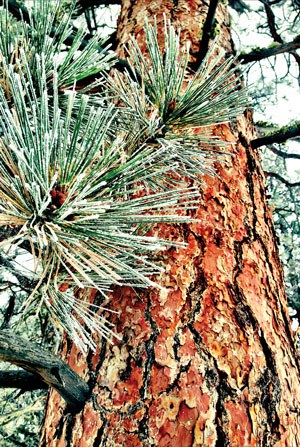
Ponderosa pines are a very common evergreen in Central Oregon. This large pine (often 60-130’ tall) can be found in dry forest lands.
Needles are 4-10” long and in bunches of 3. They are quite stiff.
Cones are 3-6” by 2-3” with stout re-curved barbs. If you pick one up, you'll notice how spiky it is.
Bark of young trees is very dark brown, but will soon furrow and mature to yellowish and to the classic red-brown. Bark breaks into plates and scales shaped like puzzle pieces. Mature ponderosas are very fire-resistant thanks to their high crowns and thick bark.
Cool Fact: If you smell the deep furrows in the bark, it often smells like butterscotch or vanilla.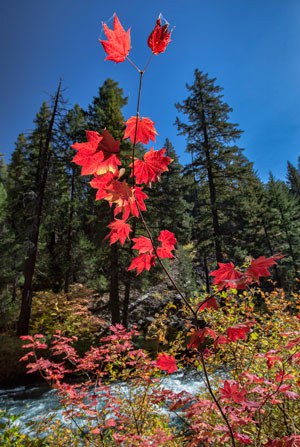
Vine maples are found along shaded stream banks in the Pacific Northwest. In the fall, they put on a spectacular show, brightening the area with their fall foliage. Trees can grow up to 25 ft. Branches are often twisting or sprawling from the base and vine-like.
Leaves are 2 1/2 - 4 1/2" long and wide with 7-11 pointed lobes that are toothed; opposite. They have veins with a notched base. They are bright green on top and paler below. Leaves turn a vibrant orange and red in the fall.
Seeds are a classic maple-- they are 1 1/2" long, paired, and winged. You'll often see them falling to the ground, looking like helicopter propellers.
Bark is greenish when young and turns gray or brown with age. It is smooth or slightly fissured.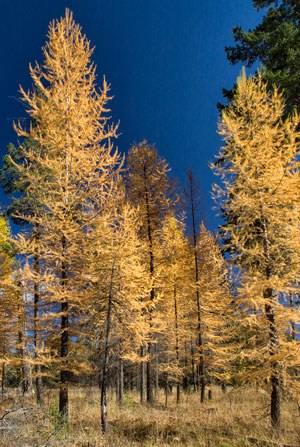
A deciduous conifer! Needles are soft, bright green in the spring and a golden yellow in the fall. Since it loses its needles every fall, it may look dead in the winter and early spring before growing new needles. This tall slender tree often reaches heights over 100’. Larch have a straight trunk with short branches near the top, creating an unusually short, narrow crown. Western larch is sometimes also referred to as tamarack.
Needles grow in dense clusters of 20-40 and are about 1” long. Needles are soft to the touch.
Cones are small (1-2”) and held upright directly along branchlets.
Bark is reddish-brown and scaly, with deep furrows between flat cinnamon-colored plates.
Learn more about larch in this video.
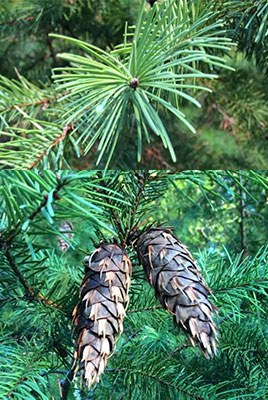
Douglas firs are an evergreen whose common name is misleading--they are not true firs. They are the most abundant tree species in Oregon and also the conifer with the greatest north-south range (from northern B.C. to Mexico). They were named after the Scottish botanist David Douglas.
Needles are single, 1/2- 1-1/2” long. They generally have a white stripe on the underside and are blunt-tipped (not sharp to the touch). Needles encircle the entire branch, making it look like a pipe cleaner.
Cones are 3-4” long. Their key characteristic are paper-thin, 3-pointed bracts that stick out beneath each woody scale on the cone. These bracts have been compared to a three-pronged pitchfork and to the hind feet and tail of a mouse diving into a hole.
Bark of mature trees is dark brown and deeply grooved.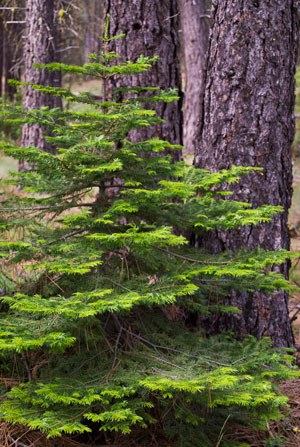
A true fir, (genus Abies) they are called that to distinguish them from Douglas-firs and a number of other “pretenders.” Grand first are medium to large trees, often growing 150-200’ tall. Grand firs tend to have a narrow shape and rigid upright or horizontal branching.
Needles are about 1” long and highly aromatic. Blunt to the touch (when talking about needles, it's helpful to remember, flat equals fir and sharp equals spruce). Needles are yellow-green on top with white bands on their underside. Needles also have two distinct lengths, alternating longer and shorter.
Cones are upright and cylindrical, growing 3-4” long. They perch on the topmost branches. Cones of true firs do not fall intact like other conifer cones. In late fall, their scales tumble off one by one when the seeds have ripened.
Bark is smooth and pale gray, becoming thicker on older trees and dividing into thick, flat-topped ridges.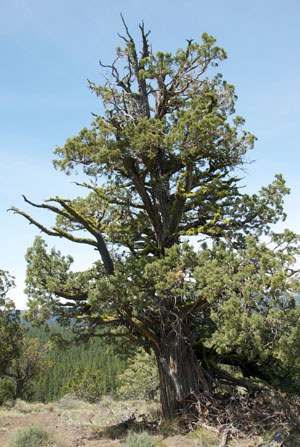
An icon of Central Oregon, Western junipers are an evergreen that have a short trunk and a dense, conical shape. They grow 25-40’ tall. Limbs nearly touch the ground. Often, you'll find junipers that are twisted and gnarled with age.
Leaves grow in whorls of three, each whorl rotated 60 degrees from the next. Mature leaves are tiny, scale-like, yellow-green, and tightly encasing the twig.
Bark is red-brown and becomes furrowed. Bark is also fibrous and tends to shred.
Cones are sometimes referred to as berries, but are actually modified cones. They are small, blue-black and resinous. The cones are possibly best known for being an ingredient in gin (although it's a different variety that is used!).
Cool Fact: Western juniper is the logo for Deschutes Land Trust!
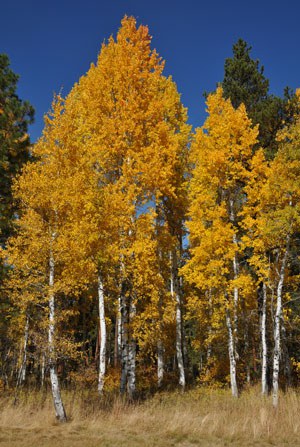
A deciduous, small tree growing 40-80’ tall with a slender main trunk. Quaking aspens get their name from their leaves, which tremble and rustle next to one another in the slightest breeze.
Leaves are heart-shaped to round and abruptly short-pointed on the ends. They are finely saw-toothed, 2-3” long. They start out a pale green in the spring before turning deeper green throughout the summer. Leaves are paler on the underside. In the fall, they turn a gorgeous gold or orange.
Bark is green-white and smooth when young, but dark and furrowed on old trees or where it has been chewed. You'll also often see "eyes" on the bark.
Cool Fact: Aspen are the widest ranging American tree, growing from Alaska to New England and down to the Rockies and Sierra Madres into Mexico. Almost 200 species of birds and mammals use aspen. Aspen are also fire-adapted! While all the trunks may die in a fire, the roots survive all but the most intense fires, sending up shoots. Entire groves are clones--genetic individuals of just one sex with interconnecting root systems. The largest known clone, in Utah, covers 106 acres! The oldest is estimated to be 80,000 years old, possibly the oldest living thing on earth.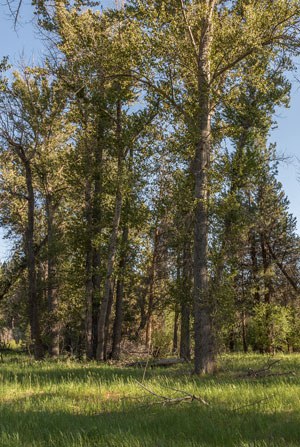
Black cottonwoods are iconically found along streams and rivers in the American West. They are fast-growing deciduous trees that can become 60-90’ tall with trunks up to 6' in diameter. They often have a broad, open crown.
Leaves are simple and alternate. They are oval to heart-shaped and finely wavy-toothed, 3-6”. They are green on top and white below. In the fall, they turn a beautiful yellow.
Seeds are 1/4" round, light brown capsules that are cottony. They mature in the spring, when you'll see what appears to be falling snow, but is actually cottony seeds disbursing in the wind.
Bark is smooth and gray on young trees, but furrowed and ridged on mature trees.
Learn more:
- The Land Trust's efforts to conserve Skyline Forest
- East Cascade Dry Forests
- Forest Bathing: How the Forest Can Help You
- Natural Climate Solutions, Explained


